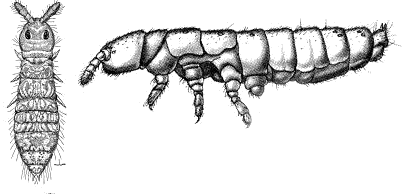|
New Jersey Scientist says: COLLEMBOLA (Habitus Odontellidae) Found in Homes with Fungal Mold identified on Human Skin in at times diagnosed as Afflicted with Delusory Parasitosis
 50-300 um 50-300 um
COLLEMBOLA (Habitus Odontellidae)
March 4, 2007, Morristown, New Jersey - Each year, thousands of Americans complain
to their physicians about itching, stinging, biting and crawling
sensations on or under their skin. Many believe they have head lice
or scabies, though they are often referred to psychiatrists or
prescribed anti-psychotic medications. But medical mycologist Prof J Dumanov suggests there is much more to this phenomena than meets the eye or the mind of the physician. The professor has identified Collembola (Habitus Odontellidae) often present and identified in his research studies of human habitations where fungal mold is present and alerts physician and dermatologists to inquire of their patients of the condition of their home. Specifically the physician must inquire and ask "is your home damp, does it have a musty smell or do you know of or see any mold?" If any of these are answered in the affirmative then an infestation by Collembola is a possibility.
2004 findings reported in the Journal of the New York Entomological Association support the professor's recent disclosure. indicating that many of these humans certainly do
have something in and on their skin and it's called - Collembola. In
90% percent of those who participated in the reported study were found to
have Collembola. All of study participants had been diagnosed with delusory parasitosis, a presumed psychiatric condition among people who
believe they are infested with an insect or parasite. Happily the findings support the argument of many patients that
they "actually have something crawling on or under their skin and
they are not delusional,"
Collembola are taxonomically hexapods, with six legs, antennas, and no wings. The common Collembla sp. springtail possess a "leaf spring" (hence the name) appendage is used for limited motility allowing them to jump up to 4 inches at a time.
Collembola feed on algae, fungi, bacteria, decaying matter and now we see them dermataphagocytes.
The professor states "The Collembola were showing up in our medical mycology reseach lab studies often and are found to be active in wet or
damp human habitations associated with a presence of fungi and mold. Eliminating the fungal mold and causation of its presence often results in the riddance of the Collembola" When asked why are they contemporaneous he says "Fungi are a delicacy to many organisms and some bugs are gourmets!"
Regarding the health effects little is known or how to
prevent or treat them as a problem for human skin but using common immunohistologicall techniques that can be ascertained by such appropriate testing and study. The professor interestingly notes that 80% of the reported population sample consist of females. He suggests the reason may be females skin is more sensitive, that the Collembola may have an attraction to hormones or even possibly perfumes or other scents.
The professor says "Yes, there are cases that are based in neurology, these too are well understood by clinicians" and he encourages "Anyone experiencing such symptoms or condition see their physician or a dermatologist first and if the symptoms persist have their home or their area of daily activity properly investigated ask them of such may be of value for the current diagnostic. Anyone suffering form a such should have a full subClinical Investigation™ performed for that purpose."
|